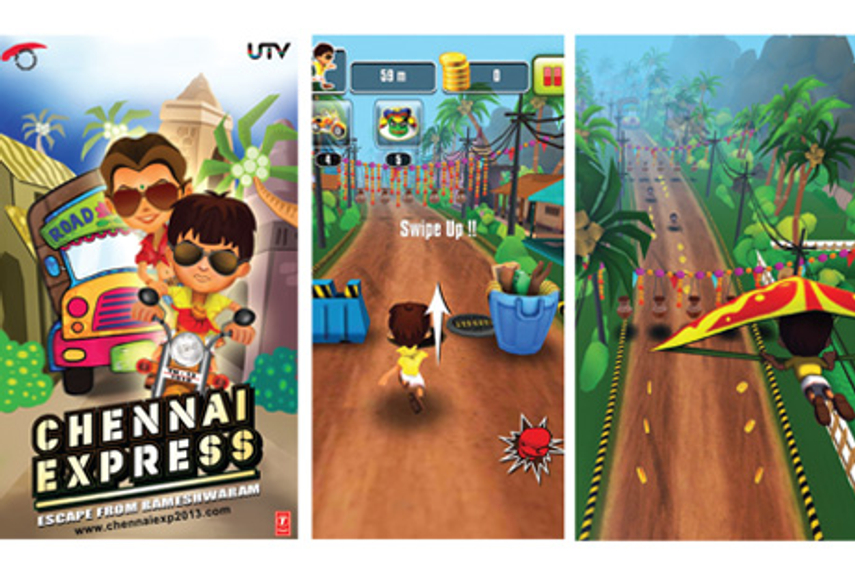
A FICCI-KPMG Indian Media and Entertainment Industry Report 2013 released in March 2013, said that the gaming industry in India stood at Rs 1,530 crore. It predicted the industry to touch Rs 4,200 crore by 2017. There are other estimates that suggest more modest future numbers, but the commonality in the predictions is of over 20 per cent growth. And 20 per cent of gaming consumed currently is based on Bollywood content, estimate industry players.
This number is perhaps less than what it could be, because currently, producers and movie makers are exploring this opportunity as a promotional tool, according to Saurabh Gupta, business head – digital, Allied Media (Delhi).
1. Growth: Sameer Ganapathy, chief operating officer-digital, Disney UTV, says, “Gaming today has emerged as one of the top entertainment sources on mobile phones in the country. Indians love Bollywood. Marrying the two together helps us create very exciting and engaging content for users. Each movie lends itself to a particular game genre. For instance, Chennai Express mobile game comes under the ‘endless runner’ category and this genre is doing very well currently. The Chennai Express mobile game has been the most successful mobile game based on a movie and continues to do well even today. With better content and increase in interaction with smartphones, this concept of games based on movies will only grow steadily.” According to him, recent mobile games based on entertainment content like Krrish, 24 and Dhoom help the genre develop. Disney UTV has developed games based on Chennai Express, Barfi!, ABCD, Ra.One, Kai Po Che and Yeh Jawaani Hai Deewani, among others.
A Bollywood-based mobile game costs anything from Rs 50 to Rs 150 per download. A game records 7,000 to 10,000 downloads on an average, with more popular movies even going up to 1,00,000 downloads. It was in 2004 that Mobile2Win developed mobile game Sholay. “The game saw 100,000 downloads then,” claims Rajiv Hiranandani, co-founder and executive director at Altruist - Mobile2win.
2. Monetisation: “Bollywood games are developed with the aim to engage audiences. Having said that, making money on the games developed is equally important considering the investment that goes into it. We look at developing games on movies, which lend themselves to a sticky gameplay and that would entice users to play it and pay for it,” says Ganapathy.
The FICCI-KPMG report also states that monetisation currently remains a challenge for Indian game publishers, as the majority of game downloads are ad-funded. However, given that most Indian smartphone users have access to content published by global content providers and the fact that the gaming universe is highly fragmented, the ad spend gets spread across a large number of developers and private publishers. Currently, the revenue models that exist in the industry include revenue sharing between game publishers and production houses, minimum guarantee-based model and the third being a mix of minimum guarantee and revenue share. The ‘high minimum guarantees’ is also a challenge, according to Hiranandani.
3. Challenges: In an interview with Campaign India earlier this year, Manish Agarwal, chief executive officer, Reliance Entertainment Digital had noted, “Consumers in India are not used to paying for games; they are used to free games or many a time they are not aware that they have paid for games they have downloaded. Poor internet speed and a mindset that is oriented towards free content make it a very difficult proposition to achieve 50 million or 100 million downloads. Therefore, for advertisers and us to invest $ 2,00,000 for a game is not feasible and this affects the quality of the game. It is a chicken and egg situation. Therefore, the games created for India are not the same as the ones created for the global markets but they are definitely better than the other locally produced content.”
According to Hiranandani, the percentage of mobile gaming based on Bollywood movies is shrinking. Why, despite every other movie adopting the game channel to create engagement? “The mobile might have reached most of all in all Indian geographies, but the internet and the 3G networks are not yet up to the mark. Even in metros, the speed of 3G is not so good. Most of the games cannot be downloaded,” he opines. The game publishers also have to create the games for all platforms, including console, mobile, Blu-Ray etc., which he explains takes a lot of time. “Moreover, how does the player differentiate between a Bollywood and non-Bollywood game given high action sequences in almost all games now?” he elaborates.
But the usage of smartphones growing. And the Mobile Internet Consumer - India 2013 report, based on a primary survey of over 2,000 mobile web and app users from India using smart phones and feature phones, notes that around 69 per cent of the audience likes downloading games or apps. The game is definitely on.
What it means…
Movie producers:
- Increased shelf life of movies
- Greater level of engagement
- Creates buzz around movies
- Extra revenue source


.jpg&h=334&w=500&q=100&v=20250320&c=1)
.jpg&h=334&w=500&q=100&v=20250320&c=1)



.jpg&h=334&w=500&q=100&v=20250320&c=1)
.jpg&h=334&w=500&q=100&v=20250320&c=1)







.jpg&h=268&w=401&q=100&v=20250320&c=1)
.jpg&h=268&w=401&q=100&v=20250320&c=1)

.jpg&h=268&w=401&q=100&v=20250320&c=1)
